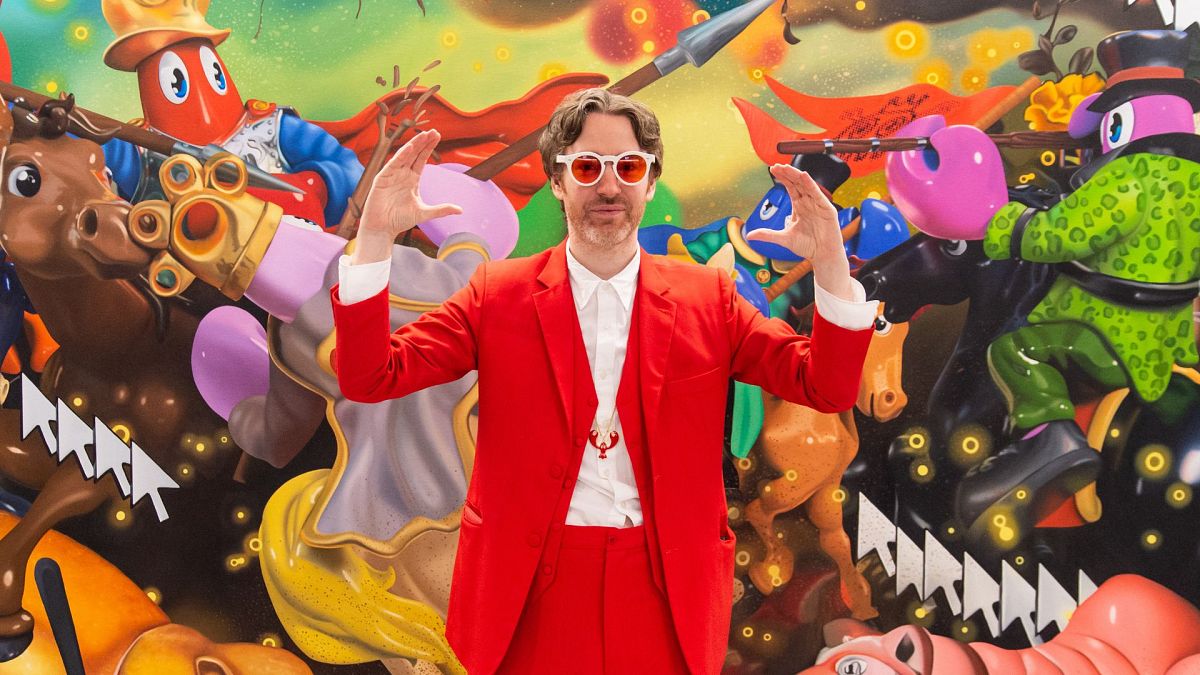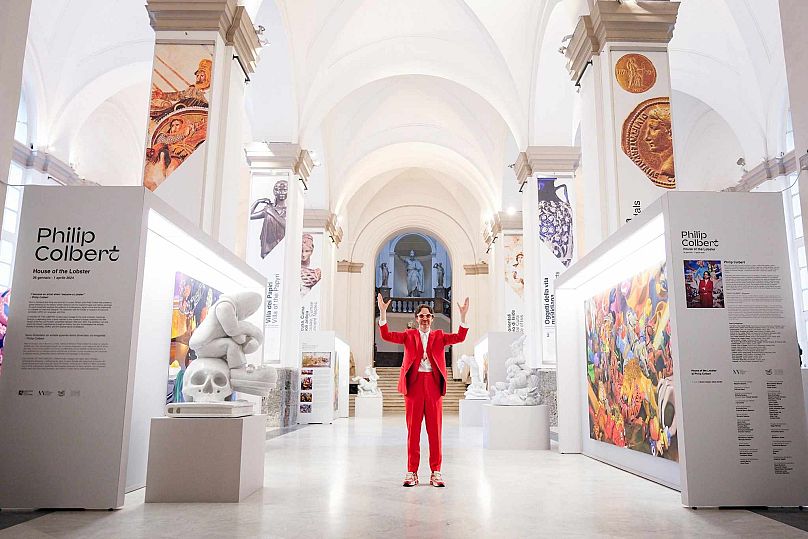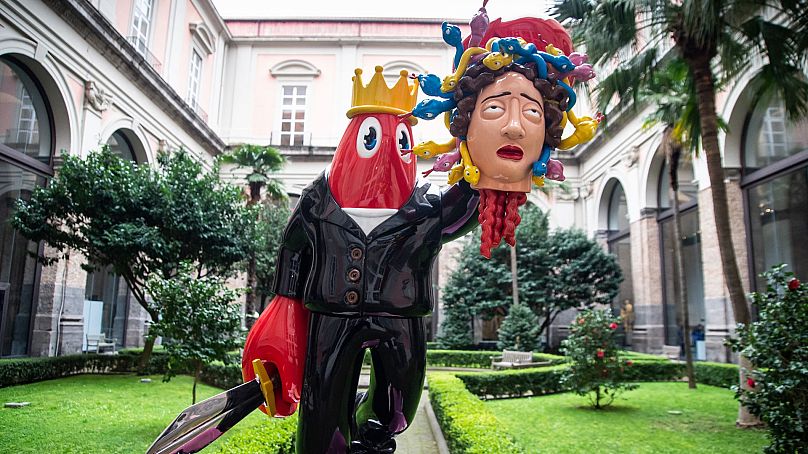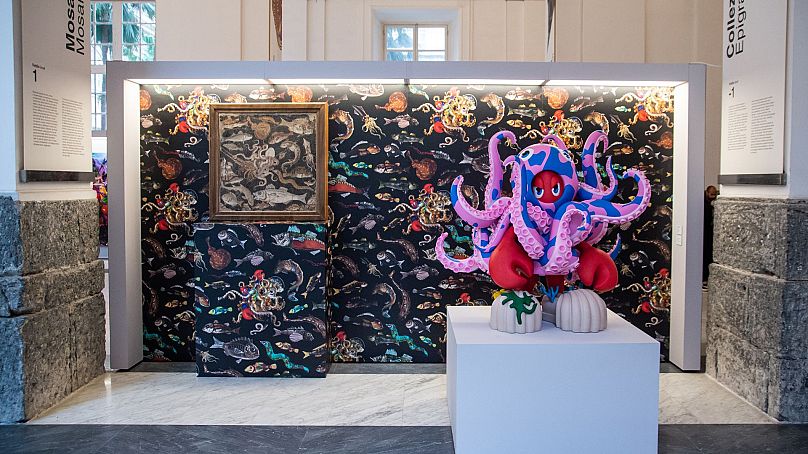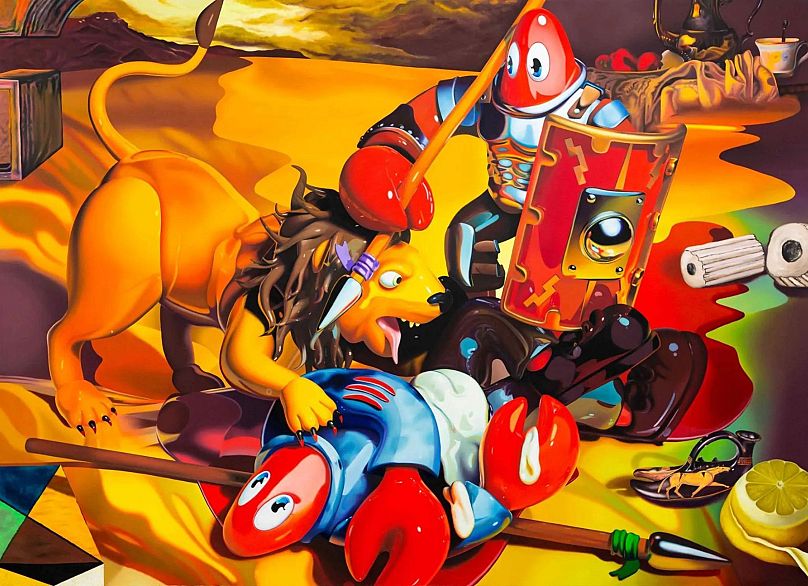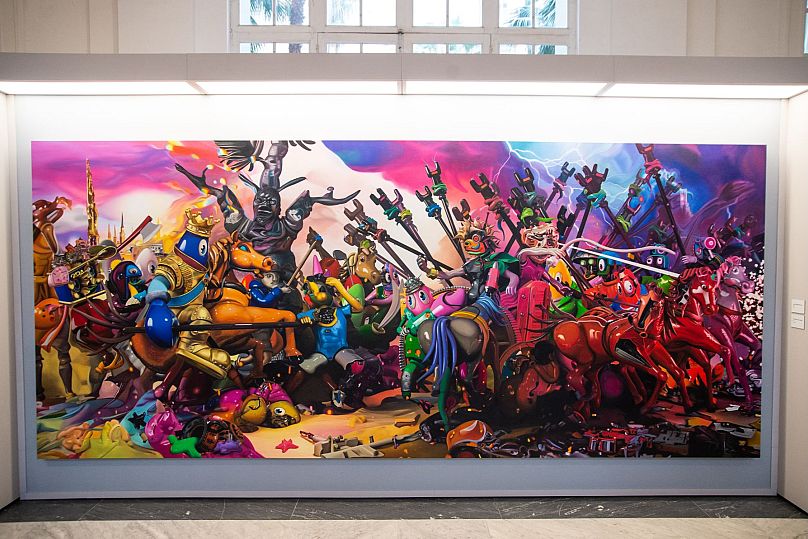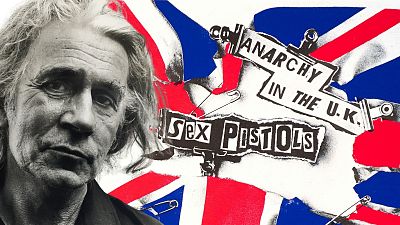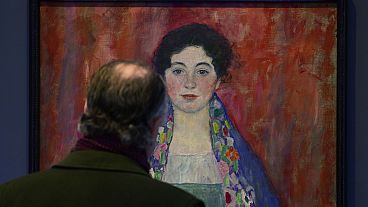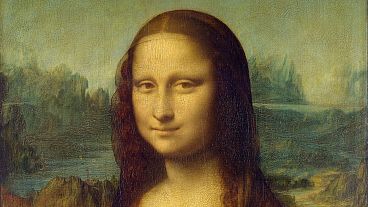Colbert's latest exhibition, 'HOUSE OF THE LOBSTER' at the National Archaeological Museum of Naples, merges his unique body of work with ancient antiquities from the museum's collection. Euronews Culture caught up with the artist...
In the eyes of most, the lobster is merely a mesmerising creature to admire behind the glass walls of an aquarium. Or potentially a delicious treat savoured at a fancy restaurant.
But for renowned British pop artist Philip Colbert, the lobster transcends its aquatic and culinary realms to become something far more profound - it represents his artistic alter ego.
"I became an artist when I became a Lobster," states Colbert.
"Growing up in Scotland, I was very far away from Walt Disney and the pop world of America. And so my imagination took over. Going to the seaside was my equivalent of going to Walt Disney and the lobster was just this alien-like creature which really caught my imagination."
With its vibrant red hue, surreal allure and significant role in art history, the lobster takes centre stage in Colbert's imaginative hyper pop universe, serving as both muse and motif in his eclectic body of work.
Last month, Colbert unveiled his latest spectacle, 'HOUSE OF THE LOBSTER,' a new exhibition running at the historic National Archaeological Museum of Naples. The show presents some of his newest creations - sculptures, paintings, and more - cleverly displayed alongside ancient antiquities from the museum's collection.
Before its opening, Euronews Culture had the pleasure of meeting the "Lobster Man" himself at his London studio - a sprawling, whimsical playground filled with inventive creations. There, we took a deep dive into his colourful artistic universe and uncovered his deep-seated infatuation with the curious crimson crustacean.
Euronews Culture: You were born in Scotland and spent a lot of time at the seaside. How has your upbringing shaped your artistic output?
Philip****Colbert: I think my upbringing has really influenced my artistic output insofar as I was born in Scotland, which is a country of myths, fairy tales, legends, the Loch Ness monster and a country of history and storytelling.
And then my connection to the lobster species really came, because also growing up in Scotland, I was very far away from Walt Disney and the pop world of America. And so my imagination took over. Going to seaside was my equivalent of going to Walt Disney and the lobster was just this alien-like creature which really caught my imagination.
As a kid, I felt very much connected to art. It was the subject that really created connection. I was fascinated by the idea of these magical frames, of these windows, which could present like this masterpiece vision of the world.
What does the lobster represent to you?
As an artist, I was obsessed with communicating through symbols and the lobster as a bright red symbol of mortality and surrealism really struck me. I later became obsessed with the symbol and then people started calling me Lobster Man.
The lobster so brilliantly summarises the idea of mortality by the fact it turns red when it's dead and it becomes so iconic in a state of being red.
Really for me my lobster persona is just a reflection of the freedom of artistic identity. As an artist I'm really free to transcend into a creation of my own imagination. And I think the lobster is my own artistic shell of my identity.
But I've also been doing a lot with the species. I've been supporting lobster hatcheries and rearing lobsters to release them into the wild.
How has the lobster been used throughout art history?
For me the lobster is really a star symbol throughout art history. It dates back to the early antiquity period where in ancient Pompeii there were many frescoes and mosaics featuring the lobster, most important of which are going to be exhibited as part of my show, "House of the Lobster" at the Archeological Museum of Naples.
But then fast forward into the Dutch still life period and the lobster appeared again as a very important mortality symbol. And then obviously more laterally in the Surrealist period, the lobster was a huge influence. There's the great mythological stories of Gérard de Nerval, the French surrealist poet, that had a pet lobster and would walk around the subway in Paris with the pet lobster on a lead.
And obviously Salvador Dalí was a huge protagonist of lobster communication. He made the lobster telephone, put the lobster on a dress, featured lobsters in many paintings. Many of his performative dinners would have huge feasts of lobsters. The lobster was almost his great muse.
How does your artistic identity manifest in your work?
Really for me, my lobster persona is just a reflection of the freedom of artistic identity. As an artist I'm really free to transcend into a creation of my own imagination. I think as humans, we have the opportunity to present our identity with the way we dress, the way we present ourselves, and that we wear effectively these masks of identity. And I think within the creative realm that freedom of identity is even further increased.
In the 21st century, my artistic freedom allows me to become this character and persona , and explore the dimensions of art as a platform across time. I merge elements of antiquity with contemporary references in my paintings, such as with my AI battle paintings, where you can see fast food and hyper pop culture references, paired with elements of antiquity.
And I like the idea of metaphysical painting - art as a way to explore what it's like to be alive, in a slightly freer, more perceptive way beyond the linear concept of time. The true reality of time is very different to this idea of past, middle and end. We live in the remnants of the past, shaping our present and defining our reality.
Ultimately, I think art is an opportunity to push freedom and create language, which is the exciting thing for humans, to have more rich cultural language to debate and contribute towards.
What can people expect from your latest exhibition'HOUSE OF THE LOBSTER' at the Archeological Museum of Naples?
My new exhibition, "House of the Lobster", is very exciting for me personally, because many of the works in the Archeological Museum of Naples are, in my mind, the blueprints of art history. My aim was to create a dialogue between the new and the old.
Important pieces, obviously for me, include the marine lobster mosaic from Pompeii, because it's one of the early great masterpieces featuring the lobster symbol. But also the great Alexander the Great mosaic, which is a masterpiece battle scene. These works laid the blueprints of Western art history, that in a way, a lot of the Renaissance painters looked back and copied.
So I'm presenting some new AI battle paintings which are in conversation with the remarkable Alexander the Great battle scene. I used the analogy of the battle scene as a tension of aesthetics. I can put my lobster characters against these mutants which I've created using AI technology. So it's a personal battle between my creativity and then creativity aided by AI.
And then I'm showing some new lobster sculptures and some new marble sculptures, which again will be shown in context to the masterpieces of antiquity marbles in the collection.
Are you inspired by music? Do you ever listen to music while you work?
Yeah, I always listen to music when I work. Sometimes if I hear a great piece of music I often think that's how I want my painting to look. Great visual art, just like great music should share this spirit of defiance against the human condition. The fact that through art, we can transcend the the limitations of our realities.
So sometimes when I listen to great music, I think that's a great benchmark of what a painting or a sculpture should do. I think it should hopefully achieve the same sense of spirit and energy that can communicate to people.
Are there any contemporary music artists you currently have on rotation?
In terms of contemporary music, I'm so in my own rabbit hole that I find it hard to always be in touch with the latest stuff. But definitely over time there's been musicians that I've had constantly on. When I was younger I remember being obsessed with Radiohead, and then Nirvana. I was even obsessed with Chopin and the Beastie Boys.
When chatting with the UK artistJon Burgermanlast year, he shared his experience of synesthesia, mentioning that he could almost hear the soundscapes of his paintings. How do you think your latest works in Naples would sound?
I love the idea of an artwork having a soundscape. And I think that the Naples show would definitely be some sort of weird steroid hybrid of a grand orchestra mixed with this sort of electronic, distorted, DJ doing very crazy experimental remixes.
What are your thoughts on the evolving landscape of the art world with the increasing popularity and continuous advancements in AI?
I think the new evolving situation with AI and art is very exciting and very disruptive, which drew me to it completely because it's this new steroid-ed, crazy medium of art. This tension between one's individual creativity and this system that AI can spit back at you, with so many iterations of your own thinking in hyperspeed is very interesting.
So I guess, like a lot of things today, it's a very dualistic thing. It's incredibly exciting, incredibly disruptive, but also quite frightening in a way. But fundamentally for me, it's quite an exciting creative opportunity, for example with my AI battle paintings. So, AI has definitely opened a lot of doors and stimulated a lot of thoughts.
Check out the video above to see insidePhilipColbert's London studio.
